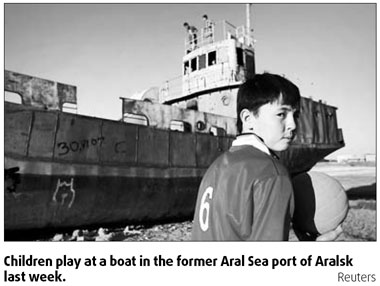Glimmer of hope for drying lake
Wind lashes against four rusty Soviet ships moored where the Aral Sea once lapped at the shores of a vibrant fishing town.
There is not a drop of water to be seen around the port of Aralsk - a silent testament to decades of Soviet experiments with nature that have turned the Aral Sea, once the world's fourth largest lake, into a salt-encrusted desert.
"Apocalypse" reads graffiti scribbled on one lonely hulk. Cows forage for scraps of dry grass on the exposed seabed where ships once landed passengers and goods.
"All of that was water," said Amanzhol Zholmaganbet, a local resident in his 70s, pointing at Aralsk's dilapidated wharves and the idle cranes that tower over the port.

The Aral Sea has shrunk by 70 percent since 1960 when Soviet planners started siphoning off water from its feeder rivers to faraway farming projects, bringing starvation and misery to traditional fishing communities.
Its sea level has dropped by 16 meters, and storms carry salt and dust from its new deserts as far away as the Himalayas.
The sea finally split into two bodies of water in 1990: a big southern part in Uzbekistan and a smaller Kazakh pocket.
Yet there is a glimmer of hope. A seven-year project led by the World Bank has helped replenish the smaller northern part of the Aral Sea by trapping water behind a dike - filling local people with a new sense of optimism and purpose.
"Good news - the sea is coming back," says a poster in the centre of Aralsk, its muddy streets sparkling with crystals of salt. Flocks of seagulls squawk as they glide above houses, and a faint hint of the sea is in the air.
The 13 km Kok-Aral dike is part of a wider, $86 million project due to be finished this year. Since it was built in 2005, the sea's turquoise waters have crept as close as 25 km to Aralsk port, from a previous distance of 100 km.
"After the small sea started filling up, we started hoping again," said Akshabat Batimova, who is helping start up a new fish-processing plant. "If there is sea, there will be life."
The World Bank is considering a follow-up project with the Kazakh government, at an estimated cost of $300 million, to improve water efficiency and restore Aralsk's waterfront.
Two fish-processing plants will open in Aralsk this year, and the fishing fleet, which vanished in the 1990s, now employs 600 people. Although the local catch remains a fraction of that seen in Soviet times, 16 types of fish are netted regularly.
"When I look back today there is only one word that really describes all the changes in this region. It's a miracle," said Kurt Christensen, a Danish environmentalist who has helped restore local fisheries since the early 1990s.
Agencies
(China Daily 06/25/2008 page11)














